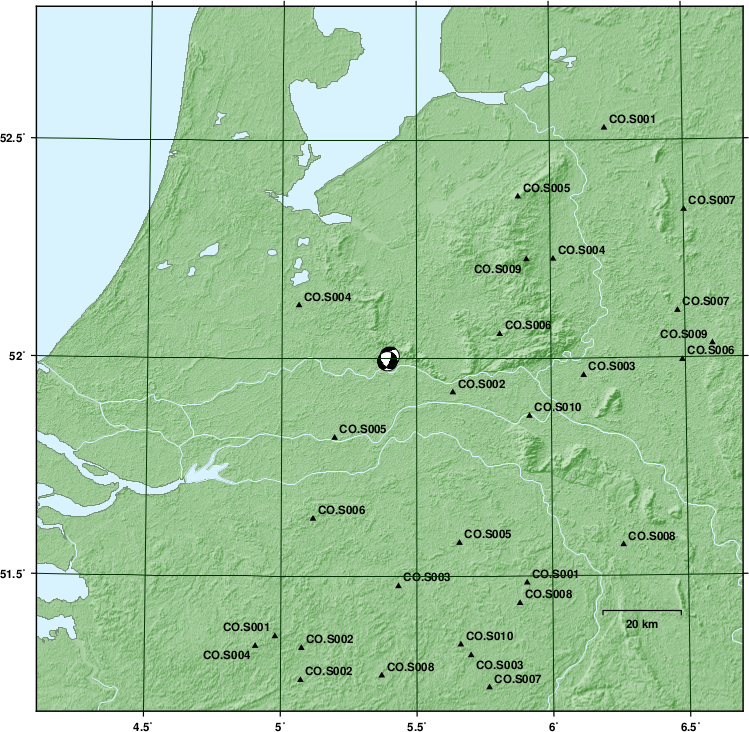Colosseo - earthquake scenario generator¶
Use pyrocko.gf Green’s Function databases to generate earthquake data from picture-book scenarios.
colosseo is a CLI for pyrocko.scenario that orchestrates different generators to randomly (yet seeded) create synthetic data of randomised sources, as well as constrained sources and fixed network geometries. Point sources or finite sources are generated with the SourceGenerator
Stations are created by the StationGenerator, dynamic or static synthetic data use the WaveformGenerator and the GNSSCampaignGenerator. Also InSAR data scenarios using kite are possible with the InSARGenerator. Network geometries can be import by ImportStationGenerator.
Creating a scenario with colosseo is straight forward, but in any case you get help with subcommands using:
$ colosseo --help
Usage: colosseo <subcommand> [options] [--] <arguments> ...
Subcommands:
init initialize a new, blank scenario
fill fill the scenario with modelled data
snuffle open Snuffler to inspect the waveform data
map map the scenario arena
To get further help and a list of available options for any subcommand run:
colosseo <subcommand> --help
Initialize a new scenario¶
Create a new scenario in a folder my_scenario:
colosseo init my_scenario
What you need is a pre-calculated Green’s function store, for more information see Fomosto - Green’s function database management.
The database to utilize for forward modelling is defined in variable store_id at the respective TargetGenerator.
The you can either copy the database into folder gf_stores or have them in your gf_store_superdirs config variable (see ~/.pyrocko/config.pf).
The scenario is built from a YAML configuration file, which can look like this:
--- !pf.scenario.ScenarioGenerator
avoid_water: true
center_lat: 52
center_lon: 5.4
radius: 90000.0
ntries: 500
target_generators:
- !pf.scenario.RandomStationGenerator
avoid_water: true
ntries: 500
nstations: 8
- !pf.scenario.WaveformGenerator
avoid_water: true
ntries: 500
station_generator: !pf.scenario.RandomStationGenerator
avoid_water: true
ntries: 500
nstations: 10
noise_generator: !pf.scenario.WhiteNoiseGenerator
scale: 1.0e-06
store_id: crust2_m5_hardtop_8Hz_fine
seismogram_quantity: displacement
vmin_cut: 2000.0
vmax_cut: 8000.0
fmin: 0.01
- !pf.scenario.InSARGenerator
avoid_water: true
ntries: 500
store_id: ak135_static
inclination: 98.2
apogee: 693000.0
swath_width: 20000.0
track_length: 15000.0
incident_angle: 29.1
resolution: [250, 250]
mask_water: true
noise_generator: !pf.scenario.AtmosphericNoiseGenerator
amplitude: 1.0
- !pf.scenario.GNSSCampaignGenerator
avoid_water: true
ntries: 500
station_generator: !pf.scenario.RandomStationGenerator
avoid_water: true
ntries: 500
nstations: 10
noise_generator: !pf.scenario.GPSNoiseGenerator
measurement_duarion_days: 2.0
store_id: ak135_static
source_generator: !pf.scenario.DCSourceGenerator
ntries: 500
avoid_water: false
nevents: 2
radius: 1000
time_min: 2017-01-01 00:00:00
time_max: 2017-01-03 00:00:00
magnitude_min: 4.0
magnitude_max: 7.0
depth_min: 5000.0
depth_max: 10000.0
Start the forward model¶
Start filling the scenario with forward modelled data:
colosseo fill my_scenario
Seismic source models¶
Double-couple source¶
See also DCSource.
--- !pf.scenario.DCSourceGenerator
# How often the are we rolling the dice for this model
ntries: 10
# Number of DCSources to generate
nevents: 2
avoid_water: false
time_min: 2017-01-01 00:00:00
time_max: 2017-01-03 00:00:00
magnitude_min: 4.0
magnitude_max: 6.0
depth_min: 0.0
depth_max: 30000.0
# b-value for Gutenberg-Richter magnitude distribution.
b_value: 1.
Rectangular fault plane¶
See also RectangularSource.
--- !pf.scenario.RectangularSourceGenerator
# How often the are we rolling the dice for this model
ntries: 10
# Number of events to generate
nevents: 2
avoid_water: false
time_min: 2017-01-01 00:00:00
time_max: 2017-01-03 00:00:00
magnitude_min: 4.0
depth_min: 0.0
depth_max: 5000.0
# Dimensions of the fault, if not given random dimensions after Mai and Berozza (2000)
# are assumed
length: 4000.
width: 2000.
# Orientation of the plane, optional
strike: 90.
dip: 34.
rake: 150.
# Decimation of sub-sources
decimation_factor: 4
Pseudo dynamic rupture¶
See also PseudoDynamicRupture.
--- !pf.scenario.PseudoDynamicRuptureGenerator
# How often the are we rolling the dice for this model
ntries: 10
# Number of events to generate
nevents: 2
avoid_water: false
time_min: 2017-01-01 00:00:00
time_max: 2017-01-03 00:00:00
magnitude_min: 4.0
depth_min: 0.0
depth_max: 5000.0
decimation_factor: 4
# Dimensions of the fault, if not given random dimensions after Mai and Berozza (2000)
# are assumed
length: 4000.
width: 2000.
# Orientation of the plane, optional
strike: 90.
dip: 34.
rake: 150.
# Decimation of sub-sources
decimation_factor: 4
The final scenario¶
The directory structure is divided into subfolders holding the forward-modelled data as well as individual folders and files for plots and meta data of stations and events (e.g. StationXML responses).
my_scenario/ # this directory hosts the scenario
|-- scenario.yml # general settings
|-- waveforms/ # generated waveforms
|-- insar/ # Kite InSAR scenes
|-- gf_stores/ # Your GF stores live here
|-- map.pdf # GMT map of the scenario
Along with the output of synthetic data the scenario’s map is plotted
